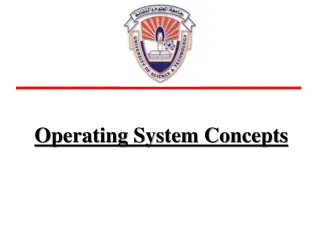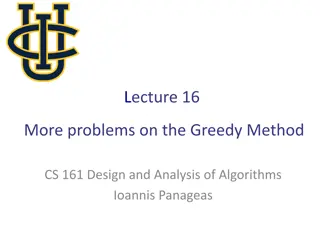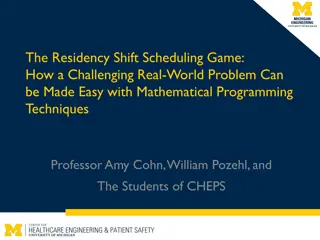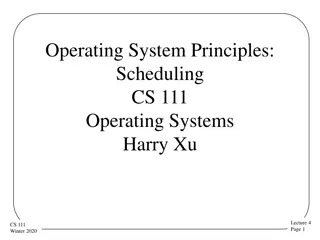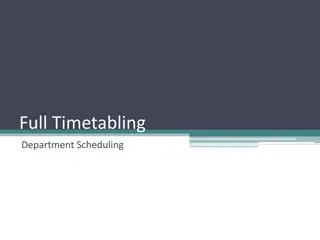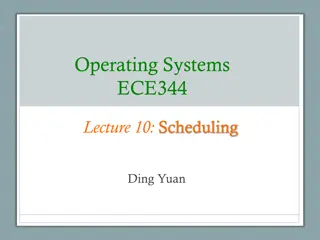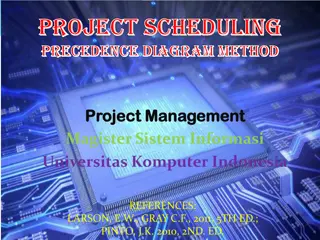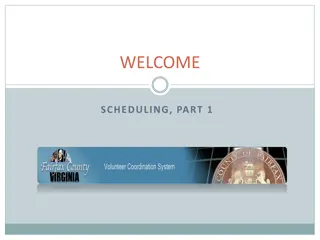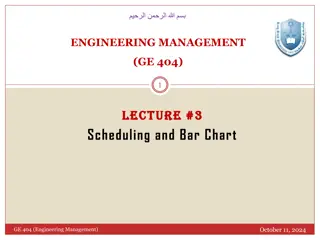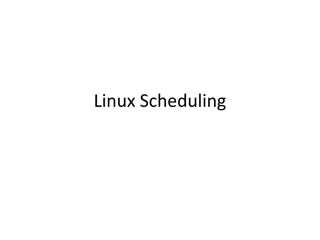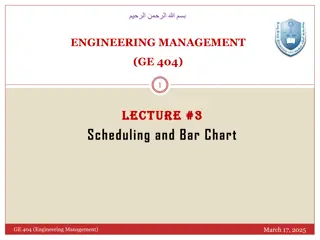Scheduling in Project Management - Effective Task Allocation
Scheduling in project management is vital for allocating tasks efficiently and meeting project deadlines. It involves defining activities, sequencing tasks, estimating resources and durations, and developing a detailed schedule. Project scheduling facilitates progress tracking, communication, issue identification, and early problem resolution.
Download Presentation

Please find below an Image/Link to download the presentation.
The content on the website is provided AS IS for your information and personal use only. It may not be sold, licensed, or shared on other websites without obtaining consent from the author.If you encounter any issues during the download, it is possible that the publisher has removed the file from their server.
You are allowed to download the files provided on this website for personal or commercial use, subject to the condition that they are used lawfully. All files are the property of their respective owners.
The content on the website is provided AS IS for your information and personal use only. It may not be sold, licensed, or shared on other websites without obtaining consent from the author.
E N D
Presentation Transcript
WELCOME TO LECTURE 5 SELESTIAN AUGUSTINO
UNIT III 3.1.0 Scheduling and time management 3.1.1 Scheduling in project management Scheduling is a mechanism to communicate what tasks need to get done and which organizational resources will be allocated to complete those tasks in what timeframe. Aproject schedule is a document collecting all the work needed to deliver the project on time. Scheduling in project management is the listing of activities, deliverables, and milestones within a project. Aschedule also usually includes the planned start and finish date, duration, and resources assigned to each activity.
3.1.1 Scheduling in project management Steps in preparation of scheduling Define activities The goal of the activity definition step is to identify all the tasks required to accomplish the product. This frequently results in identifying all the work products and deliverables that comprise the project. These deliverables are found as the components of a work breakdown structure. Sequence activities During this step, you identify any dependencies of related tasks and document them in the project schedule. You need to analyse each of the tasks to understand which task has a dependency on additional tasks.
3.1.1 Scheduling in project management Estimate activity resources The next step is to identify the resources and their availability to your project. Remember that not all team members may be 100% available to your project as some team members may be working on multiple projects. In this step, you assign resources to each of the tasks Estimate activity durations With resources assigned, the next step is to estimate each task's duration. The activity's duration is the number of working periods required to complete the task. This can be defined in days, weeks, and even months! It is also important to understand the difference of the different duration types including fixed work, fixed duration and fixed units.
3.1.1 Scheduling in project management Develop schedule The next step is to analyse the project schedule and examine the sequences, durations, resources and inevitable scheduling constraints. The goal of this step is to validate the project schedule correctly models the planned work. In this step you not only validate the duration estimates are accurate, but validate the resource allocations are correct.
3.1.1 Scheduling in project management Advantages of project schedule Project scheduling provides the following benefits: Assists with tracking, reporting on, and communicating progress. Ensures everyone is on the same page as far as tasks, dependencies, and deadlines. Helps highlight issues and concerns, such as a lack of resources. Helps identify task relationships. Can be used to monitor progress and identify issues early.
3.1.1 Scheduling in project management Uses of project schedule The schedule places project tasks into a sequence of linked events with dates and, in some cases, the times for each to be started and finished. The project schedule creates a model for the entire project to guide the work being done and to measure progress against a fixed timetable
3.1.1 Scheduling in project management Classifications of project schedule The three most common classes of project schedules are:- a) Master Project Schedule b) Milestone Schedule c) Detailed Project Schedule
3.1.1 Scheduling in project management Classifications of project schedule a) Master Project Schedule The master project schedule is a summary level schedule which highlights the principal activities and tasks and their estimated duration. It is developed in the initial phase of project planning. The schedule is also useful for facilitating team brainstorming during the initial phases of the project to work out logistics.
3.1.1 Scheduling in project management Classifications of project schedule b) Milestone Schedule The milestone schedule is a summary level schedule that allows the project team leader to review and identify all of the significant and major project related milestones that may surface during the course of a project. As an advanced schedule, it is often referred to the project s life cycle. It is recommended for reporting status reports to top level management and external stakeholders. The milestone schedule is also useful during team assessments, particularly for newly-formed teams to give them opportunity to take pride in their accomplishments, reflect upon their setbacks, and most importantly bond as a team.
3.1.1 Scheduling in project management Classifications of project schedule c) Detailed Project Schedule Detailed schedules are operational schedules intended to help front line managers in directing hourly, daily, or weekly project work. The detailed schedule is considered as the execution playbook for the project. The detailed project schedule playbook can be broken down into chapters to show the detailed schedule for each activity or each phase of the project.
3.1.2 Project scheduling techniques/methods Basically work schedules are created by listing the activities, determining activity durations and assigning activity relationships. Gantt Charts, PERT Diagrams, and CPM are the most common project planning and scheduling techniques and methods used for creating work schedules. One or all of these techniques can be used based on the requirements and the complexity of the project. Gantt Charts 1. Gantt Charts are also known as bar charts. Activities are represented as bars and the length of each bar represents the activity duration. The beginning of the bar shows the start date and the end of the bar shows the end date of the activity. Depending on the project execution plan and resource availability, these bars may be sequential or run in parallel. Gantt Charts are simple tools, therefore, project management teams and stakeholders can easily understand it and manage their projects by the help of it. Gantt Chart is the most frequently used scheduling technique because of its simplicity.
2. Critical Path Method (CPM) The critical path is the longest path of the network diagram. In this method, activities are listed, activity durations are determined, dependencies between the activities are established and the longest path is identified by making forward and backward calculations. The critical path method is a visual technique which enables to show activities, activity dependencies, and durations in the same diagram. It is a common method for determining the completion date of a project. However, it is difficult to determine the critical path of a large and complex project without using the software.
3. Program Evaluation Review Technique (PERT) PERT stands for Program Evaluation Review Technique. In this method, activities are listed, activity durations are determined by using three estimate techniques, dependencies between the activities are established and the longest path is identified by making forward and backward calculations. The three estimate techniques are; i. Most Likely Estimate (m) ii. Optimistic Estimate (o) iii. Pessimistic Estimate (p) Simply put, most likely estimate refers to the most possible time required to complete the task. Optimistic estimate refers to the shortest time required to complete the task. Pessimistic estimate refers to the longest time required to complete the task. Expected time of the task is calculated by using these three estimates.
3. Program Evaluation Review Technique (PERT) In PERT Method, project completion time relies on the calculation of the expected duration for each activity. The critical path method is used in conjunction with the PERT Method. You can determine the critical path of the project by performing forward and backward calculations. However PERT is a time consuming method which requires software to implement.
To provide safety to workers To avoid damage due to construction activities to the nearby properties To store construction materials as near the place of utilization as possible
3.1.4 Work Breakdown Chart(WBC) WBC is a structural schematic diagram that decomposes tasks layer by layer according to an internal structure or an implementation process. It breaks down the project into several relatively independent, single content, and easy accounting work units. A great work breakdown structure will lead to better team productivity and comprehensive project management. Main Uses of Work Breakdown Chart Work breakdown chart is widely used for different occasions. Those uses could be summarized as 3 tools as follow: It helps project managers and their teams to identify and manage project work effectively. It is a structural design tool that clearly expresses the interconnections between the various project tasks. It defines milestones that report project completion to senior management teams and clients as a reporting tool for project status.
Benefits of Work Breakdown Chart a) Clarify project responsibilities It is a good way to help project managers focus on the goals and clarify the responsibilities. Each responsibility has its direction to corresponding tasks which can be easily confirmed. b) Improve the accuracy of time, cost, and resources It is detailed in the decomposition of tasks so that estimated time, cost, and resources are covered concisely. All the resources related to tasks no matter it is big or small will be broken down accurately. c) Establish a framework for further projects One complete WBC covers effective information for giving instructions to the further projects. Other team members can get into the framework soon and generate their own WBC easily so as to improve efficiency.
d) Analyse the initial risk of projects In fact, WBC decomposition layer is not necessarily fixed, and its lowest level can be determined according to the level of risk. e) Define a benchmark for performance management It defines a concise standard for measuring the performances during the whole project. You can monitor from the first layer of overall tasks to the smallest work units. f) Build project members commitment As it is the foundation of information communication, you could use it as a basis for budgeting, progressing and describing other aspects of the project which enables all project-related personnel and groups. Thus they are able to understand the work required to complete the project.
3.1.5 Network for project management Aproject network is a graph (weighted directed graph) depicting the sequence in which a project's terminal elements are to be completed by showing terminal elements and their dependencies. What is a network diagram in project management? A network diagram is a graphical representation of all the tasks, responsibilities and work-flow for a project. It often looks like a chart with a series of boxes/ovals/circles and arrows. It is used to map out the schedule and work sequence for the project, as well as track its progress through each stage, up to and including completion. Since it encompasses every single action and outcome associated with the project, a network diagram also illustrates the scope of the project.
Types of network diagrams There are two main types of network diagrams in project management: the Arrow Diagramming Method (ADM), also known as Arrow Network(AN) or Activity On Arrow(AOA) ; and the Precedence Diagramming Method (PDM), also known as Node Network(NN) or Activity On Node(AON). Arrow Diagram Method (ADM) The arrow diagramming method uses arrows to represent activities associated with the project. ADM has the features: The tail of the arrow represents the start of the activity and the head represents the finish. The length of the arrow typically denotes the duration of the activity. Each arrow connects two boxes/circles, known as nodes. The nodes are used to represent the start or end of an activity in a sequence. The only relationship between the nodes an activity in an ADM chart can represent is that of finish to start or FS.
Precedence Diagram Method (PDM) In the precedence diagramming method for creating network diagrams, each box, or node, represents an activity, with the arrows representing relationships between the different activities. The arrows can therefore represent all four possible relationships: Finish to Start (FS): This is used when an activity cannot start before another activity finishes. Start to Start (SS): This is used to illustrate when two activities are able to start simultaneously. Finish to Finish (FF): This is used when two tasks need to finish together Start to Finish (SF): This is an uncommon dependency and only used when one activity cannot finish until another activity starts. PDM network diagrams are frequently used in project management today.
3.1.6 Event An event or node or connector is the beginning and end points of an activity. One may say, it is the specific instant of time, which makes the start or end of an activity. Event consumes neither time nor resources. This is usually represented by circles in a network. The events can be further classified into two categories namely: a) Merge Event When two or more activities come from an event it is known as merge event. b) Burst Event When more than one activity leaves an event is known as burst event. See the diagram in the next slide
3.1.7 Activity An activity means any individual operation, which utilizes resources and has a beginning and an end. An arrow is used to depict an activity with its head indicating the direction of progress in the project. One may say, an activity is the actual performance of the task and requires time and resources for its completion. Example; site clearance, excavation, setting out, concrete mixing, steel fixing etc.
Types of activities It is of four types namely: a) Predecessor activity Activity that must be completed immediately prior to the start of another activity. b) Successor activity Activity which cannot be started until one or more of other activities are completed but immediately succeed them are called successor activity. c) Concurrent Activity which can be accomplished concurrently is known as concurrent activity. An activity can be predecessor or successor to an event or it may be concurrent with the one or more of the other activities. d) Dummy activity An activity which does not consume any kind of resources but merely depicts the technological dependence is called a dummy activity. Dummy activity is inserted in a network to classify the activity pattern in the following situations: i) To make activities with common starting and finishing points distinguishable. ii) To identify and maintain the proper precedence relationship between activities those are not connected by events
Lets consider a situation where A and B are concurrent activities and activity D is dependent on B and C is dependent on both A and B. Such a situation can be handled by use of dummy activity.
When two or more activities are exactly parallel such that they would start at the same node (event) and finish at the same node. A dummy would be inserted between the end of one of the activities and the common finishing node.
3.1.8 Basic assumptions in creating network diagram 1. The project can be broken down into a group of activities 2. Each activity can be assigned a duration 3. The logic relationship between activities are known and fixed 4. All the arrows in the network are straight and point toward right 5. There is no cross-crossing arrows 6. There should be no looping
3.1.9 Rules for drawing a network diagram The following rules are all logically based and should be thoroughly learned before attempting to draw networks. 1) A complete network should have only one point of entry (start event) and only one point of exit (finish event). Meaning that, the event numbered 1 is the start event and an event with highest number is the end/finish event. 2) Each activity is represented by one and only one arrow in the network. 3) Every activity must have one preceding or tail event and one succeeding or head event. Note that many activities may use the same tail event and many may use the same head event. 4) No activity can start until its tail event is reached. Meaning that, before an activity can be undertaken, all activities preceding it must be completed. That is, the activities must follow a logical sequence (or interrelationship) between activities.
3.1.9 Rules for drawing a network diagram 5) An event is not complete until all activities leading into it are complete.. 6) Loops i.e. a series of activities which lead back to the same event are not allowed because the logical meaning of networks is a progression of activities always moving onwards in time. 7) No single activity can be represented more than once in a network. The length of an arrow has no specific dimension. 8) In assigning numbers to events, there should not be any duplication of event numbers in a network. 9) Events are numbered in ascending order from left to right 10) Dummy activities must be used only if it is necessary to reduce the complexity of a network.
3.1.9 Fulkersons rule for numbering the events 1. Identify the starting or initial event and number it as 1 2. Delete all the emerging arrows from event 1 to create at least one more new initial event. 3. Number these initial events as 2,3, . 4. Delete all the emerging arrows from these numbered events in order to create new initial events. 5. Follow step 3 6. Continue the process until the last event is obtained. Assign this event with the largest number.
Example 1: Draw a network for a house construction project. The sequence of activities with their predecessors is given in the following table, below. Sequence of activities for house construction project
Example 2: Consider the project given in the following table and construct a network diagram. Sequence of activities for building construction project
Self study a) Briefly explain organization of D.I, work register, record for tools and plants in not more than four pages.
END OF LECTURE 5 THANK YOU SELESTIAN AUGUSTINO






